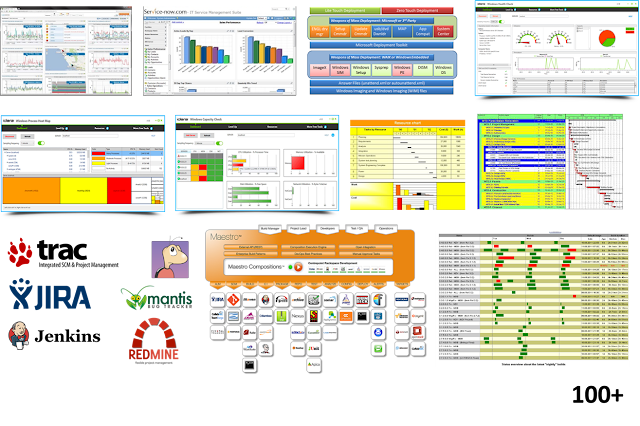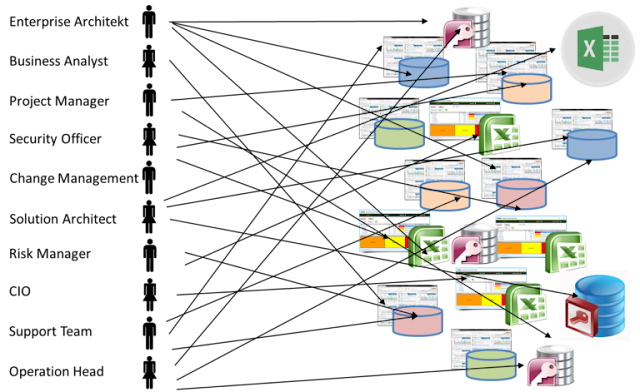If everything is to be processed faster, better and at a lower cost in the future, automation and the smooth integration of functions and processes will not be a thing of the past. The agile methods, which are currently very vogue, are also aimed at. However, I would not like to deny that this is primarily a question of cultural aspects. In this article, however, I would like to highlight the effects on the tool landscape in companies.
IT services are complex structures, sometimes complicated. In order for an IT service to fly in its end-to-end view, many specialists and external providers are required to make their contribution. There is virtually no one in a company that knows exactly how IT services are made and assembled by a particular IT service. Every function involved brings in his special knowledge and organizes himself around his responsibility.
The IT organizations sit in their silo towers and settle "their" world is long known. The cultural clashes, which are warned in the demand for better cooperation, does not come by chance. This also begins with the strategy and planning of new IT projects. At the very beginning of an idea, the view of a later IT service is not just nebulised - it is often not even existing. The idea is then poured into solutions and, depending on the involved teams, then passed from Silo Tower to Silo Tower. Each silo is committed to integrating the new solution into its world and landscape and to supplement it with data and functions until ultimately it is made available to the impatient user after several hurdles in a productive environment.
Until now this was not really a problem. Inadequacies could be caught and cleansed locally between the adjacent teams. One always remains guilty of each other. But now the wind has turned. The Unicorns make it: the clock rate must be drastically increased. New operating models with cloud services are now part of the portfolio. New methods like DevOps, Continuous Integration and Delivery are announced. As the existing teams are not able to take over the work they have done, they go to the factory with dedicated teams and build their own worlds - one could also say "new silos".
IT services are complex structures, sometimes complicated. In order for an IT service to fly in its end-to-end view, many specialists and external providers are required to make their contribution. There is virtually no one in a company that knows exactly how IT services are made and assembled by a particular IT service. Every function involved brings in his special knowledge and organizes himself around his responsibility.
The IT organizations sit in their silo towers and settle "their" world is long known. The cultural clashes, which are warned in the demand for better cooperation, does not come by chance. This also begins with the strategy and planning of new IT projects. At the very beginning of an idea, the view of a later IT service is not just nebulised - it is often not even existing. The idea is then poured into solutions and, depending on the involved teams, then passed from Silo Tower to Silo Tower. Each silo is committed to integrating the new solution into its world and landscape and to supplement it with data and functions until ultimately it is made available to the impatient user after several hurdles in a productive environment.
Until now this was not really a problem. Inadequacies could be caught and cleansed locally between the adjacent teams. One always remains guilty of each other. But now the wind has turned. The Unicorns make it: the clock rate must be drastically increased. New operating models with cloud services are now part of the portfolio. New methods like DevOps, Continuous Integration and Delivery are announced. As the existing teams are not able to take over the work they have done, they go to the factory with dedicated teams and build their own worlds - one could also say "new silos".
Any initiative with new tools and processes
And this is one of the cornerstones of today's IT operations. Each organizational unit today has its own tools with often isolated data sets. Not infrequently in IT organizations more than 100 tools and tens of Excel tables are in use with a multiple of interfaces which are more or less documented. An overview of the tools is generally not available and the quality of the data is in many cases doubtful. Each team implements «its» processes according to their own needs and obtains the tools that ideally meet their requirements. The data are not available, and certainly not transparent or secured.
100 and more tools are the rule
.
What is not conceivable in the manufacture of products in the business is in the IT. There is no comprehensive data structure and information chain in planning, implementation, implementation and operation. If certain roles such as Project Manager, Change Manager or Solution Architect want to know more about the manufacturing process, then he does not have a clear view of where and what data is reliable. It is not uncommon for him to ask them in the organization. Even after that, he is not really sure whether he can rely on reliable data. The fact that such constellations ultimately lead to surprises, that the original idea about the various stations up to the operation is no longer identical, may not really be surprising.
Who has what data?
If automation is the key to continuous integration and deployment, this type of IT operating model is not enough. And though the various guardians try to keep their tools with interfaces and APIs in the game in order to allow a toolchain. Faster, better and above all cheaper it will not.
It takes a tool governance and a tool architecture to meet the demands of the future. It has to be over, that each team and every specialist procures the best tool for him and collects for himself data, which have no further benefit in the enterprise. IT4IT can play a good foundation and reference here.
IT4IT TM is not simply a new process model, which attempts to repress the established and more or less well-implemented frameworks such as ITIL® or COBIT®. It is rather a missing today to the well-known frameworks with detailed descriptions for an integrated IT operating model as the necessary IT functionality is designed, procured and implemented. IT4IT TM is based on the following four pillars:
- Data & Information Model - a data entity model with all core data objects, attributes, and relationships
- Functional model - the definition of the central IT management systems for the management of the data and the automation
- Integration model - for linking processes, data and systems to deliver value
- Service model - The backbone of the value chain model is based on the service LifeCycle
IT4IT - The four pillars
IT4IT can now be a good starting point for creating a viable toolchain architecture. Although IT4IT has not yet been definitively defined in all the details, there is a function and information structure geared to the required added value.
IT4IT - The four contiguous value streams









you seem to have used HPE IP (in fact my slides). I request you remove them.
ReplyDelete